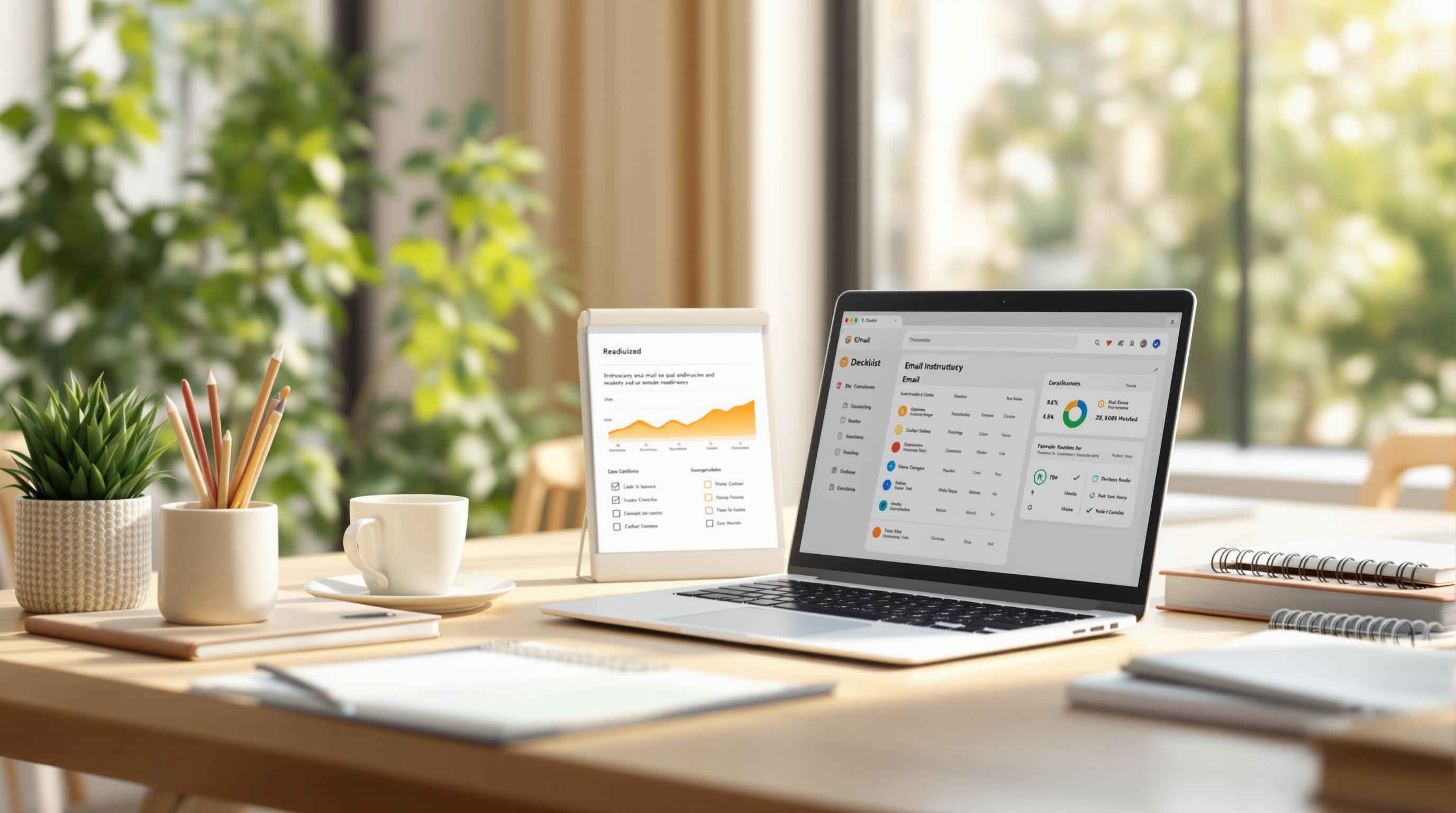Protecting user privacy in email campaigns is essential for compliance and trust. Here's how you can anonymize data effectively:
- Why anonymize? To comply with privacy laws like GDPR, build user trust, and reduce risks from data breaches.
- What data to protect? Focus on high-priority data like email addresses, names, and behavioral patterns.
- How to anonymize? Use methods like pseudonymization, masking, encryption, and aggregation to secure user data while retaining analytics.
- Tools to use: Leverage built-in anonymization features in email platforms or third-party tools for added security.
- Stay compliant: Conduct regular audits and train employees on privacy best practices.
This guide simplifies anonymization techniques to help you run secure, privacy-friendly email campaigns without losing valuable insights.
Types of User Data in Email Campaigns
Data Points Collected
Email campaigns gather a range of user information. It's important to prioritize anonymization efforts based on the potential risks tied to each type of data:
| Data Category | Examples | Anonymization Priority |
|---|---|---|
| Personal Identifiers | Email addresses, Names | High |
| Contact Information | Phone numbers, Addresses | High |
| Behavioral Data | Opens, Clicks, Time spent | Medium |
| Technical Data | IP addresses, Device info | Medium |
| Demographics | Age, Location, Gender | Medium |
These data categories are essential for campaign performance but come with different levels of anonymization needs.
Sensitive Data and Compliance Risks
Under GDPR, sensitive data includes direct identifiers (like names and emails), indirect identifiers (data combinations), and behavioral patterns that might reveal someone's identity.
Personal Identifiable Information (PII) is particularly risky and falls into three main types:
- Direct identifiers: Information such as email addresses or names that directly pinpoint an individual.
- Indirect identifiers: Data points that, when combined, can identify someone.
- Behavioral patterns: Tracking details that expose habits or preferences.
Reviewing Data Collection
Before choosing anonymization techniques, follow these three key steps:
1. Data Inventory Assessment
List all data collected in email campaigns, along with where it's stored.
2. Risk Evaluation
Determine the potential consequences if specific data were exposed.
3. Collection Method Analysis
Examine how data is collected, ensuring consent and transparency are part of the process.
This analysis helps decide on the most effective anonymization methods, which will be discussed in the next section.
Methods for Anonymizing User Data
Pseudonymization and Masking
Pseudonymization and masking help turn sensitive data into non-identifiable formats while still keeping it useful for analysis. For example, Brevo's anonymous email tracking system uses these methods effectively [1].
Here are some common masking techniques for email campaign data:
| Data Type | Masking Method | Example |
|---|---|---|
| Email Addresses | Partial Masking | j***@domain.com |
| IP Addresses | Range Masking | 192.168.xxx.xxx |
| Names | Token Replacement | User_7842 |
Masking ensures individual data points are protected. Meanwhile, encryption goes a step further by securing entire datasets.
Encryption and Storage Security
Encryption is a key method for safeguarding sensitive email campaign data. Modern encryption techniques convert user information into unreadable formats [3].
Some best practices for encryption include:
- Encrypting stored data to protect it from unauthorized access.
- Securing data transfers to prevent interception during transmission.
- Controlling decryption keys to ensure only authorized parties can access the data.
Aggregation and K-Anonymity
K-anonymity ensures that individuals can't be singled out within a group of similar records [3]. This involves techniques like:
- Grouping open rates by campaign rather than tracking individual users.
- Analyzing click patterns by region instead of by specific IP addresses.
- Reporting demographic trends (e.g., age groups) instead of individual data points.
"Removing all user identifiers that can be used for fingerprinting and re-identifying is better to keep your company secure." [2]
This approach aligns with GDPR's focus on minimizing data collection by emphasizing group-level patterns over individual tracking. Implementing these methods often requires specialized tools, which will be discussed next.
Tools for Data Anonymization
Email Marketing Platform Features
Many email marketing platforms come with built-in tools to help safeguard user data through anonymization. Here's how you can use these features:
- Access Platform Settings: Go to your platform's privacy and security settings. For example, in Brevo, navigate to Campaigns > Settings > Default settings > Tracking.
- Configure Tracking Options: Turn on anonymous tracking to monitor email opens and clicks without linking activity to individual users.
External Anonymization Tools
If your platform's built-in features don't meet your needs, third-party tools can provide extra data protection. These tools specialize in ensuring sensitive information remains secure while maintaining functionality.
| Tool Type | Primary Function | Key Benefits |
|---|---|---|
| Data Masking Tools | Hide sensitive information | Keeps data usable for analysis |
| Encryption Software | Protect data during storage and transfer | Prevents unauthorized access |
| Analytics Anonymizers | Strip identifying details | Helps maintain compliance |
Email Service Business Directory: Finding Tools
The Email Service Business Directory is a helpful resource for finding platforms with strong anonymization options. When exploring tools, keep in mind your Data Inventory Assessment (Section 2.3) and focus on these factors:
- Data Protection Features: Prioritize platforms with built-in anonymization tools.
- Compliance Standards: Make sure the tools meet GDPR and other privacy regulations.
- Integration Options: Check if the tools work seamlessly with your existing systems.
This approach ensures your data practices remain secure and compliant with relevant regulations.
sbb-itb-6e7333f
Maintaining Anonymized Data
Regular Audits
Once you've implemented the tools from Section 4, keeping your anonymized data in check is crucial. Regular reviews help ensure data remains secure and compliant. Here's a suggested schedule:
- Monthly: Check data sources and collection methods for accuracy.
- Quarterly: Evaluate risks related to compliance.
- Bi-annually: Test and confirm the effectiveness of security measures.
- Annually: Refresh and revise policies to align with new regulations and business objectives.
These steps help keep your anonymization efforts aligned with evolving standards and operational needs.
Employee Training on Privacy
Your team plays a critical role in managing sensitive data responsibly. To prepare them, focus on training that covers:
- Data Privacy Basics: Teach core concepts of data protection and anonymization.
- Incident Management: Help employees identify and report potential data breaches effectively.
- Tool Usage: Train staff to use anonymization features within email marketing and other platforms.
This builds on the compliance groundwork from Section 1.2, turning theory into actionable knowledge.
Balancing Anonymization and Marketing
Protecting data while running effective marketing campaigns is all about balance. Building on the pseudonymization and aggregation techniques from Section 3, consider these strategies:
- Use pseudonymization to retain key marketing insights while stripping away direct identifiers.
- Leverage aggregated analytics for tracking campaign performance without revealing individual user details.
- Apply hashed email addresses to segment audiences while safeguarding personal contact information.
Conclusion and Key Points
Key Points Summary
Anonymization plays a crucial role in safeguarding both user privacy and marketing efforts in today’s privacy-conscious world. This guide has outlined methods and tools designed to protect user data without compromising the effectiveness of marketing strategies.
Modern email marketing platforms now include anonymization features that simplify privacy protection. For example, Brevo offers anonymous tracking, ensuring engagement metrics are not tied to individual users [1].
When paired with the tools discussed in Section 4, these approaches create a strong, compliance-ready framework for running campaigns responsibly.
Final Thoughts on Privacy and Marketing
The anonymization techniques covered in Sections 3 and 4 form a solid base for ethical email marketing. Coupled with employee training and audits from Section 5, maintaining privacy requires ongoing effort and adaptability to keep up with changing regulations.
For continued support, revisit the tools and platform comparisons provided in Section 4 to refine your approach.
FAQs
How is anonymous data created?
There are three main methods:
- Data masking: Alters identifiable details into an unreadable format while keeping the data functional.
- Pseudonymization: Replaces personal identifiers with artificial values, preventing any direct link to individuals.
- Encryption: Converts sensitive information into a secure format, requiring specific keys for access.
What are the main techniques for data anonymization?
Here are six methods commonly used in email campaigns:
| Technique | Description | Ideal Use Case |
|---|---|---|
| Data Masking | Hides original data by modifying it | Protecting email addresses and contact details |
| Pseudonymization | Substitutes identifiers with artificial values | Tracking campaign engagement |
| Data Generalization | Groups data into broader ranges | Demographic segmentation |
| Data Perturbation | Slightly alters values while preserving overall trends | Analytics and reporting |
| Data Swapping | Interchanges values between records | Managing email lists |
| Synthetic Data | Generates artificial data with real-world patterns | Testing and development |
For detailed steps, refer back to the pseudonymization and masking methods in Section 3.
Which data masking technique works best?
Encryption is often the top choice for email marketing. As demonstrated by Stape's Anonymizer tool, encryption secures sensitive data by converting it into an unreadable format, accessible only with a decryption key [2].


